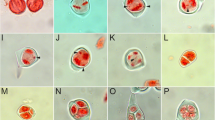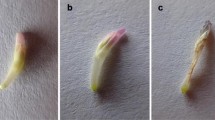Abstract
Fertilization is a general feature of eukaryotic uni- and multicellular organisms to restore a diploid genome from female and male gamete haploid genomes. In angiosperms, polyploidization is a common phenomenon, and polyploidy would have played a major role in the long-term diversification and evolutionary success of plants. As for the mechanism of formation of autotetraploid plants, the triploid-bridge pathway, crossing between triploid and diploid plants, is considered as a major pathway. For the emergence of triploid plants, fusion of an unreduced gamete with a reduced gamete is generally accepted. In addition, the possibility of polyspermy has been proposed for maize, wheat and some orchids, although it has been regarded as an uncommon mechanism of triploid formation. One of the reasons why polyspermy is regarded as uncommon is because it is difficult to reproduce the polyspermy situation in zygotes and to analyze the developmental profiles of polyspermic triploid zygotes. Recently, polyspermic rice zygotes were successfully produced by electric fusion of an egg cell with two sperm cells, and their developmental profiles were monitored. Two sperm nuclei and an egg nucleus fused into a zygotic nucleus in the polyspermic zygote, and the triploid zygote divided into a two-celled embryo via mitotic division with a typical bipolar microtubule spindle. The two-celled proembryos further developed and regenerated into triploid plants. These suggest that polyspermic plant zygotes have the potential to form triploid embryos, and that polyspermy in angiosperms might be a pathway for the formation of triploid plants.


Similar content being viewed by others
References
Antoine AF, Faure JE, Dumas C, Feijó JA (2001) Differential contribution of cytoplasmic Ca2+ and Ca2+ influx to gamete fusion and egg activation in maize. Nat Cell Biol 3:1120–1123
Blackman VH (1898) On the cytological features of fertilization and related phenomena in Pinus silvestris L. Philos Trans R Soc Lond B Biol Sci 190:395–426
Blanc G, Wolfe KH (2004) Widespread paleopolyploidy in model plant species inferred from age distributions of duplicate genes. Plant Cell 16:1667–1678
Bleckmann A, Alter S, Dresselhaus T (2014) The beginning of a seed: regulatory mechanisms of double fertilization. Front Plant Sci 5:452
Brawley SH (1991) The fast block against polyspermy in fucoid algae is an electrical block. Dev Biol 144:94–106
Bretagnolle F, Thompson JD (1995) Tansley Review No. 78. Gametes with the somatic chromosome number: mechanisms of their formation and role in the evolution of autopolyploid plants. New Phytol 129:1–22
Comai L (2005) The advantages and disadvantages of being polyploid. Nat Rev Genet 6:836–846
Cui L, Wall PK, Leebens-Mack JH, Lindsay BG, Soltis DE, Doyle JJ, Soltis PS, Carlson JE, Arumuganathan K, Barakat A, Albert VA, Ma H, dePamphilis CW (2006) Widespread genome duplications throughout the history of flowering plants. Genome Res 16:738–749
Denninger P, Bleckmann A, Lausser A, Vogler F, Ott T, Ehrhardt DW, Frommer WB, Sprunck S, Dresselhaus T, Grossmann G (2014) Male–female communication triggers calcium signatures during fertilization in Arabidopsis. Nat Commun 5:4645
Faure JE, Digonnet C, Dumas C (1994) An in-vitro system for adhesion and fusion of maize gametes. Science 263:1598–1600
Grant V (1981) Plant Speciation, Ed 2. Columbia University, New York
Guignard ML (1899) Sur les antherozoides et la double copulation sexuelle chez les vegetaux angiosperms. Rev Gén de Bot 11:129–135
Hagerup O (1947) The spontaneous formation of haploid, polyploid, and aneuploid embryos in some orchids. Kongel Dan Vidensk Selsk Biol Medd 20:1–22
Hamamura Y, Saito C, Awai C, Kurihara D, Miyawaki A, Nakagawa T, Kanaoka MM, Sasaki N, Nakano A, Berger F, Higashiyama T (2011) Live-cell imaging reveals the dynamics of two sperm cells during double fertilization in Arabidopsis thaliana. Curr Biol 21:497–502
Hamamura Y, Nishimaki M, Takeuchi H, Geitmann A, Kurihara D, Higashiyama T (2014) Live imaging of calcium spikes during double fertilization in Arabidopsis. Nat Commun 5:4722
Hu CH, Ho KM (1963) Karyological studies of triploid rice plants. Bot Bull Acad Sin 4:30–36
Iwao Y (2012) Egg activation in physiological polyspermy. Reproduction 144:11–22
Kasahara RD, Maruyama D, Hamamura Y, Sakakibara T, Twell D, Higashiyama T (2012) Fertilization recovery after defective sperm cell release in Arabidopsis. Curr Biol 22:1084–1089
Kato A (1997) Induced single fertilization in maize. Sex Plant Reprod 10:96–100
Kihara H, Ono T (1926) Chromosomenzahlen und systematische Gruppierung der Rumex-Arten. Z Zellforsch Mikr Anat 4:475–481
Köhler C, Mittelsten Scheid O, Erilova A (2010) The impact of the triploid block on the origin and evolution of polyploid plants. Trends Genet 26:142–148
Kranz E, von Wiegen P, Lörz H (1995) Early cytological events after induction of cell division in egg cells and zygote development following in vitro fertilization with angiosperm gametes. Plant J 8:9–23
Leitch IJ, Bennett MD (1997) Polyploidy in angiosperms. Trends Plant Sci 2:470–476
Lloyd C, Chan J (2006) Not so divided: the common basis of plant and animal cell division. Nat Rev Mol Cell Biol 7:147–152
Maruyama D, Hamamura Y, Takeuchi H, Susaki D, Nishimaki M, Kurihara D, Kasahara RD, Higashiyama T (2013) Independent control by each female gamete prevents the attraction of multiple pollen tubes. Dev Cell 25:317–323
Maruyama D, Völz R, Takeuchi H, Mori T, Igawa T, Kurihara D, Kawashima T, Ueda M, Itoh M, Umeda M, Nishikawa S, Groß-Hardt R, Higashiyama T (2015) Rapid elimination of the persistent synergid through a cell fusion mechanism. Cell 161:907–918
Masterson J (1994) Stomatal size in fossil plants: evidence for polyploidy in majority of angiosperms. Science 264:421–424
McWilliam JR, Mergen F (1958) Cytology of fertilization in Pinus. Bot Gaz 199:246–249
Nagasato C, Motomura T, Ichimura T (1999) Influence of centriole behaviour on the first spindle formation in zygotes of the brown alga Fucus distichus (Fucales, Phaeophyceae). Dev Biol 208:200–209
Navara CS, First NL, Schatten G (1994) Microtubule organization in the cow during fertilization, polyspermy, parthenogenesis, and nuclear transfer: the role of the sperm aster. Dev Biol 162:29–40
Nawaschin S (1898) Revision der Befruchtungsvorgange bei Lilium martagon und Fritillaria tenella. Bull Sci Acad Imp Sci Saint Pétersbourg 9:377–382
Ohnishi Y, Hoshino R, Okamoto T (2014) Dynamics of male and female chromatin during karyogamy in rice zygotes. Plant Physiol 165:1533–1543
Raghavan V (2003) Some reflections on double fertilization, from its discovery to the present. New Phytol 159:565–583
Ramsey J (2007) Unreduced gametes and neopolyploids in natural populations of Achillea borealis (Asteraceae). Heredity 98:143–150
Ramsey J, Schemske DW (1998) Pathways, mechanisms, and rates of polyploid formation in flowering plants. Annu Rev Ecol Syst 29:467–501
Rhoades MM (1936) Note on the origin of triploidy in maize. J Genet 33:355–357
Rick CM (1945) A survey of cytogenetic causes of unfruitfulness in the tomato. Genetics 30:347–362
Runions CJ, Owens JN (1999) Sexual reproduction of interior spruce (Pinaceae). II. Fertilization to early embryo formation. Int J Plant Sci 160:641–652
Russell SD (1992) Double fertilization. Int Rev Cytol 140:357–390
Sandfaer J (1975) The occurrence of spontaneous triploids in different barley varieties. Hereditas 80:149–153
Sandfaer J (1979) Frequency of aneuploids in progenies of autotriploid barley, Hordeun vulgare L. Hereditas 90:213–217
Santelices B (2002) Recent advances in fertilization ecology of macroalgae. J Phycol 38:4–10
Schuel H (1984) The prevention of polyspermic fertilization in sea urchins. Biol Bull 167:271–309
Scott RJ, Armstrong SJ, Doughty J, Spielman M (2008) Double fertilization in Arabidopsis thaliana involves a polyspermy block on the egg but not the central cell. Mol Plant 1:611–619
Snook RR, Hosken DJ, Karr TL (2011) The biology and evolution of polyspermy: insights from cellular and functional studies of sperm and centrosomal behavior in the fertilized egg. Reproduction 142:779–792
Spielman M, Scott RJ (2008) Polyspermy barriers in plants: from preventing to promoting fertilization. Sex Plant Reprod 21:53–65
Sprague GF (1929) Hetero-fertilization in maize. Science 69:526–527
Sprague GF (1932) The nature and extent of hetero-fertilization in maize. Genetics 17:358–368
Suarez EY, Lopez AG, Naranjo CA (1992) Polyspermy versus unreduced male gametes as the origin of nonaploids (9x) common wheat plants. Caryologia 45:21–28
Tarin JJ (2000) Fertilization in protozoa and metazoan animals: a comparative overview. In: Tarin JJ, Cano A (Eds.) Fertilization in protozoa and metazoan animals cellular and molecular aspects. Springer, Berlin, pp 277–314
Toda E, Ohnishi Y, Okamoto T (2016) Development of polyspermic rice zygotes. Plant Physiol 171:206–214
Uchiumi T, Uemura I, Okamoto T (2007) Establishment of an in vitro fertilization system in rice (Oryza sativa L.). Planta 226:581–589
Wong JL, Wessel GM (2006) Defending the zygote: search for the ancestral animal block to polyspermy. Curr Top Dev Biol 72:1–151
Acknowledgements
We thank Ms. T. Mochizuki (Tokyo Metropolitan University) for isolating rice gametes. This work was supported in part by the Ministry of Education, Culture, Sports, Science and Technology of Japan (Grants-in-Aid no. 26113715 to T.O.) and the Japan Society for the Promotion of Science (Grant-in-Aid no. 16K14742 to T.O.).
Author information
Authors and Affiliations
Corresponding author
Rights and permissions
About this article
Cite this article
Okamoto, T., Ohnishi, Y. & Toda, E. Development of polyspermic zygote and possible contribution of polyspermy to polyploid formation in angiosperms. J Plant Res 130, 485–490 (2017). https://doi.org/10.1007/s10265-017-0913-9
Received:
Accepted:
Published:
Issue Date:
DOI: https://doi.org/10.1007/s10265-017-0913-9




